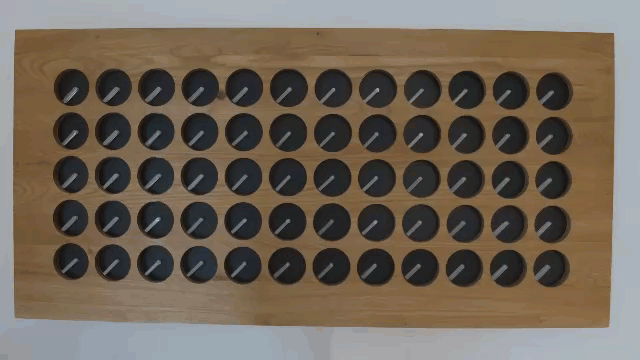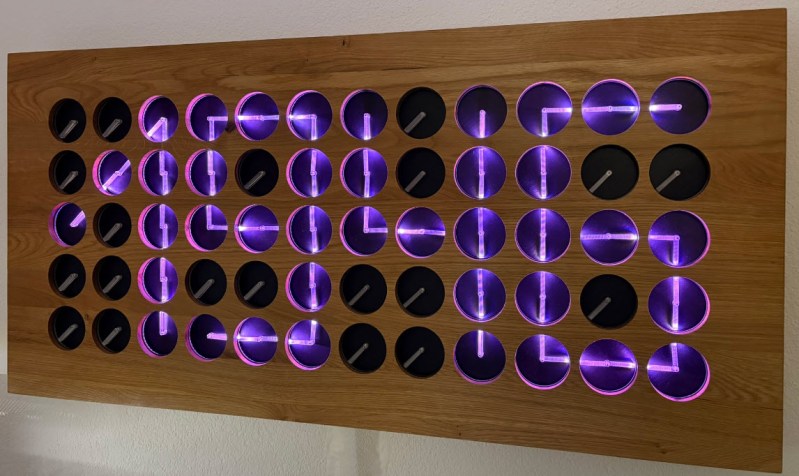Some people just want to have their cake and eat it too, but very few of us ever get to pull it off. [Erich Styger] has, though with V5 of his “MetaMetaClock”— a clock made of clocks, that uses the orientation of the hands to create digits.
We’ve seen previous versions of this clock. As before, the build is exquisitely detailed and all relevant files are on GitHub. This version keeps the acrylic light-pipe hands of version 4, but adds more of them: 60 clocks vs 24. Larger PCBs are used, grouping the dual-shaft steppers into groups of four, instead of the individual PCBs used before. Each PCB has an NXP LPC845 (a Cortex M0 microcontroller) that communicates on an RS-485 bus. Placing four steppers per microcontroller reduces parts count somewhat compared to previous versions (which had each ‘clock’ on its own modular PCB) albeit at the cost of some flexibility.
While the last version used veneers on its face, this version is cut by CNC by from a large slab of oak. It’s certainly the most attractive version yet, and while bigger isn’t always better, more clock faces means more potential effects. Date? Time? Block letters? Arbitrary text? Kaleidoscopic colours from the RGB LEDs? It’s all there, and since it’s open source, anyone who builds one can add more options. A BLE interface makes it quick and easy to wirelessly switch between them or set the time.
It’s nice sometimes to watch projects like this improve incrementally over time. [Erich] mentions that he plans to add Wifi and a web-based user interface for the next version. We look forward to it, and are grateful to [jicasi] for the tip. Just as it is always clock time at Hackaday, so you can always toss a tip of your own into the box.


















So, if you want to see what this would look like before building all those clocks, you could cut 60 holes in a piece of cardboard, place it over a 40″ LCD, and tile a bunch of analog clock animations in that single display.
But that loses much of the cachet, I suppose. It isn’t art without the pain.
You really even need the cardboard…
Somehow, a “don’t” got missing.
I idly wondered how Technology Connections got that nice even colourful lighting in the back of the display cabinets behind him.
Then one day he explained it – a couple of big TVs mounted behinds the cabinets displaying a coloured checkerboard pattern.
Does it bother anyone else that both hands on each clock are the same length? A piece of heat shrink tubing or tape around the end of one hand would make it appear shorter, but still accept light into the end.
If one hands was shorter, then the resulting gaps would annoy you more.
Would they though? I would know that the gaps were there because one hand was shorter than the other, which is as expected.
The length difference doesn’t have to be huge.
Yeah, because the gaps will be in the wrong spot.
I’ve been working on my own version of this over the last 1.5 years after seeing a previous iteration of this and being amazed by it. Im hoping to complete it soon. Hats off to you- I know how involved and daunting these things are, but also really rewarding. Mine will be walnut with brass hands (and 24 clocks). I didn’t document it nearly as well, but I’ll send some pictures and maybe we’ll see it here.